Detailed Analysis of Goodfellow PLC Investment Appraisal Report
VerifiedAdded on 2020/11/23
|15
|3684
|433
Report
AI Summary
This comprehensive report assesses the investment potential of Goodfellow PLC's house-building project. It employs various capital budgeting techniques, including payback period, accounting rate of return (ARR), net present value (NPV), and internal rate of return (IRR), to evaluate the project's financial viability. The report provides detailed calculations and analysis of each technique, considering factors like selling prices, construction costs, inflation, and fixed infrastructure expenses. The analysis aims to assist the Board of Directors in making informed decisions regarding the proposed investment, offering insights into the potential returns and risks associated with the project. The report highlights the advantages and disadvantages of each appraisal method, offering a well-rounded perspective on the project's financial implications.

Comprehensive Report of Goodfellow PLC
Paraphrase This Document
Need a fresh take? Get an instant paraphrase of this document with our AI Paraphraser
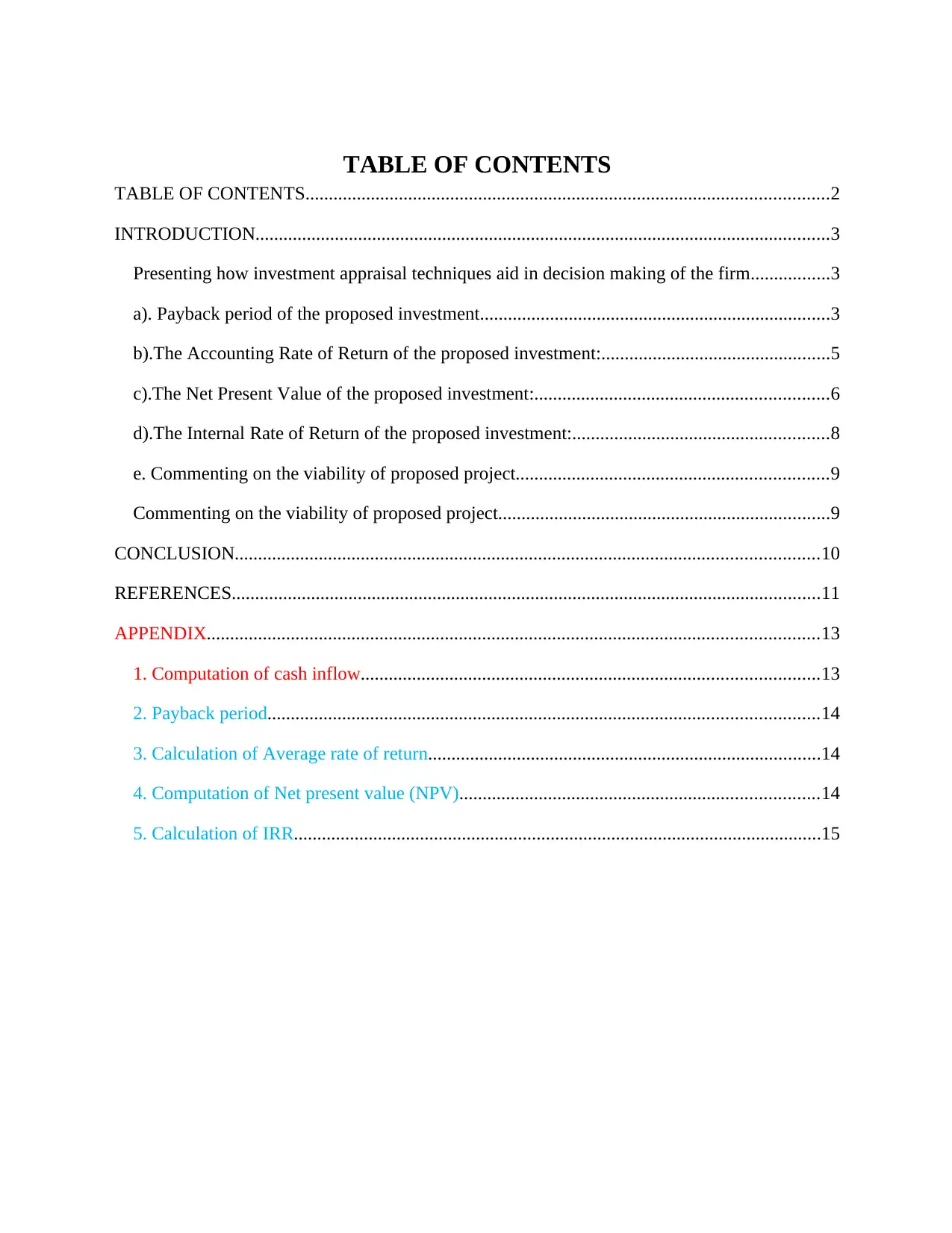
TABLE OF CONTENTS
TABLE OF CONTENTS................................................................................................................2
INTRODUCTION...........................................................................................................................3
Presenting how investment appraisal techniques aid in decision making of the firm.................3
a). Payback period of the proposed investment...........................................................................3
b).The Accounting Rate of Return of the proposed investment:.................................................5
c).The Net Present Value of the proposed investment:...............................................................6
d).The Internal Rate of Return of the proposed investment:.......................................................8
e. Commenting on the viability of proposed project...................................................................9
Commenting on the viability of proposed project.......................................................................9
CONCLUSION.............................................................................................................................10
REFERENCES..............................................................................................................................11
APPENDIX...................................................................................................................................13
1. Computation of cash inflow..................................................................................................13
2. Payback period......................................................................................................................14
3. Calculation of Average rate of return....................................................................................14
4. Computation of Net present value (NPV).............................................................................14
5. Calculation of IRR.................................................................................................................15
TABLE OF CONTENTS................................................................................................................2
INTRODUCTION...........................................................................................................................3
Presenting how investment appraisal techniques aid in decision making of the firm.................3
a). Payback period of the proposed investment...........................................................................3
b).The Accounting Rate of Return of the proposed investment:.................................................5
c).The Net Present Value of the proposed investment:...............................................................6
d).The Internal Rate of Return of the proposed investment:.......................................................8
e. Commenting on the viability of proposed project...................................................................9
Commenting on the viability of proposed project.......................................................................9
CONCLUSION.............................................................................................................................10
REFERENCES..............................................................................................................................11
APPENDIX...................................................................................................................................13
1. Computation of cash inflow..................................................................................................13
2. Payback period......................................................................................................................14
3. Calculation of Average rate of return....................................................................................14
4. Computation of Net present value (NPV).............................................................................14
5. Calculation of IRR.................................................................................................................15
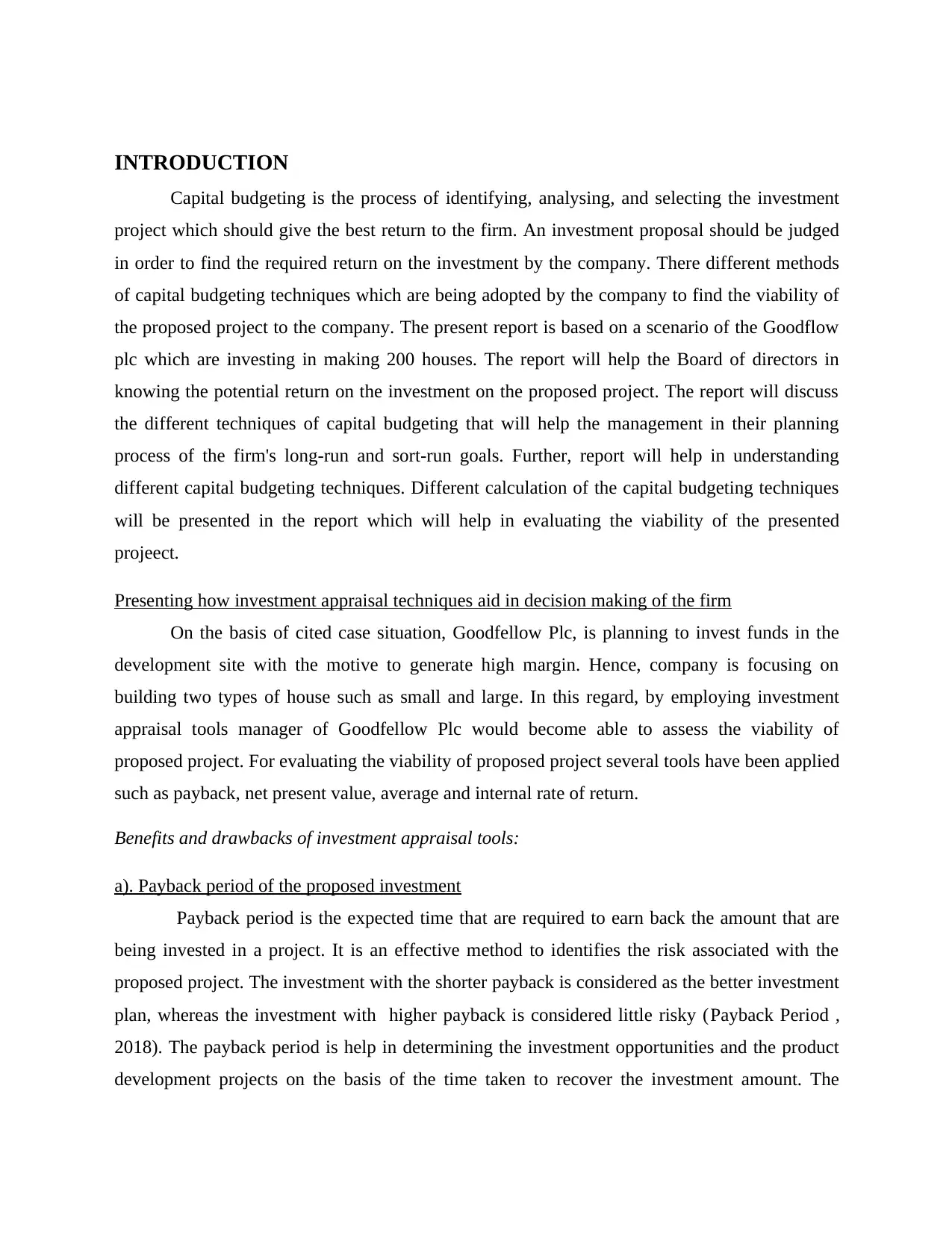
INTRODUCTION
Capital budgeting is the process of identifying, analysing, and selecting the investment
project which should give the best return to the firm. An investment proposal should be judged
in order to find the required return on the investment by the company. There different methods
of capital budgeting techniques which are being adopted by the company to find the viability of
the proposed project to the company. The present report is based on a scenario of the Goodflow
plc which are investing in making 200 houses. The report will help the Board of directors in
knowing the potential return on the investment on the proposed project. The report will discuss
the different techniques of capital budgeting that will help the management in their planning
process of the firm's long-run and sort-run goals. Further, report will help in understanding
different capital budgeting techniques. Different calculation of the capital budgeting techniques
will be presented in the report which will help in evaluating the viability of the presented
projeect.
Presenting how investment appraisal techniques aid in decision making of the firm
On the basis of cited case situation, Goodfellow Plc, is planning to invest funds in the
development site with the motive to generate high margin. Hence, company is focusing on
building two types of house such as small and large. In this regard, by employing investment
appraisal tools manager of Goodfellow Plc would become able to assess the viability of
proposed project. For evaluating the viability of proposed project several tools have been applied
such as payback, net present value, average and internal rate of return.
Benefits and drawbacks of investment appraisal tools:
a). Payback period of the proposed investment
Payback period is the expected time that are required to earn back the amount that are
being invested in a project. It is an effective method to identifies the risk associated with the
proposed project. The investment with the shorter payback is considered as the better investment
plan, whereas the investment with higher payback is considered little risky (Payback Period ,
2018). The payback period is help in determining the investment opportunities and the product
development projects on the basis of the time taken to recover the investment amount. The
Capital budgeting is the process of identifying, analysing, and selecting the investment
project which should give the best return to the firm. An investment proposal should be judged
in order to find the required return on the investment by the company. There different methods
of capital budgeting techniques which are being adopted by the company to find the viability of
the proposed project to the company. The present report is based on a scenario of the Goodflow
plc which are investing in making 200 houses. The report will help the Board of directors in
knowing the potential return on the investment on the proposed project. The report will discuss
the different techniques of capital budgeting that will help the management in their planning
process of the firm's long-run and sort-run goals. Further, report will help in understanding
different capital budgeting techniques. Different calculation of the capital budgeting techniques
will be presented in the report which will help in evaluating the viability of the presented
projeect.
Presenting how investment appraisal techniques aid in decision making of the firm
On the basis of cited case situation, Goodfellow Plc, is planning to invest funds in the
development site with the motive to generate high margin. Hence, company is focusing on
building two types of house such as small and large. In this regard, by employing investment
appraisal tools manager of Goodfellow Plc would become able to assess the viability of
proposed project. For evaluating the viability of proposed project several tools have been applied
such as payback, net present value, average and internal rate of return.
Benefits and drawbacks of investment appraisal tools:
a). Payback period of the proposed investment
Payback period is the expected time that are required to earn back the amount that are
being invested in a project. It is an effective method to identifies the risk associated with the
proposed project. The investment with the shorter payback is considered as the better investment
plan, whereas the investment with higher payback is considered little risky (Payback Period ,
2018). The payback period is help in determining the investment opportunities and the product
development projects on the basis of the time taken to recover the investment amount. The
⊘ This is a preview!⊘
Do you want full access?
Subscribe today to unlock all pages.

Trusted by 1+ million students worldwide
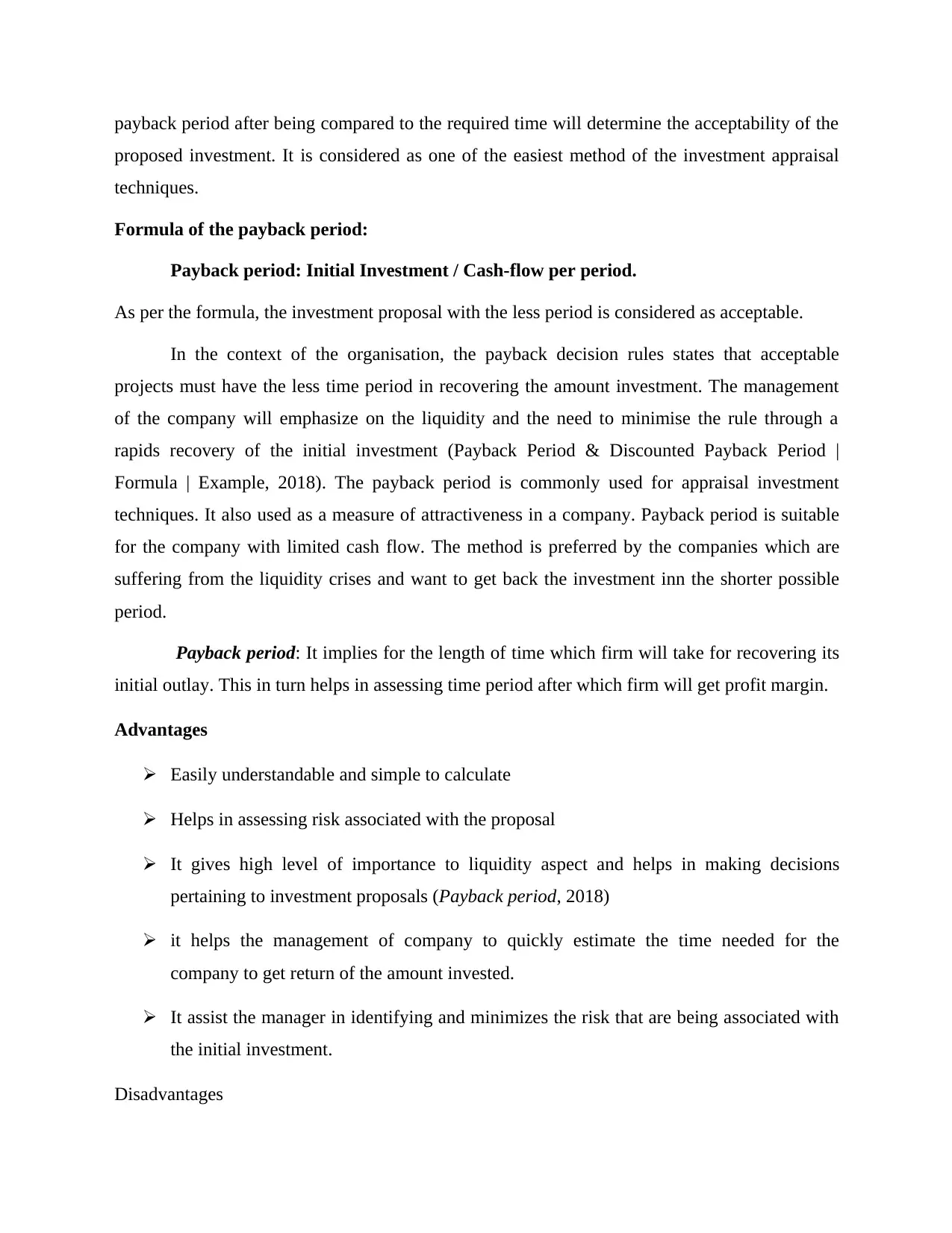
payback period after being compared to the required time will determine the acceptability of the
proposed investment. It is considered as one of the easiest method of the investment appraisal
techniques.
Formula of the payback period:
Payback period: Initial Investment / Cash-flow per period.
As per the formula, the investment proposal with the less period is considered as acceptable.
In the context of the organisation, the payback decision rules states that acceptable
projects must have the less time period in recovering the amount investment. The management
of the company will emphasize on the liquidity and the need to minimise the rule through a
rapids recovery of the initial investment (Payback Period & Discounted Payback Period |
Formula | Example, 2018). The payback period is commonly used for appraisal investment
techniques. It also used as a measure of attractiveness in a company. Payback period is suitable
for the company with limited cash flow. The method is preferred by the companies which are
suffering from the liquidity crises and want to get back the investment inn the shorter possible
period.
Payback period: It implies for the length of time which firm will take for recovering its
initial outlay. This in turn helps in assessing time period after which firm will get profit margin.
Advantages
Easily understandable and simple to calculate
Helps in assessing risk associated with the proposal
It gives high level of importance to liquidity aspect and helps in making decisions
pertaining to investment proposals (Payback period, 2018)
it helps the management of company to quickly estimate the time needed for the
company to get return of the amount invested.
It assist the manager in identifying and minimizes the risk that are being associated with
the initial investment.
Disadvantages
proposed investment. It is considered as one of the easiest method of the investment appraisal
techniques.
Formula of the payback period:
Payback period: Initial Investment / Cash-flow per period.
As per the formula, the investment proposal with the less period is considered as acceptable.
In the context of the organisation, the payback decision rules states that acceptable
projects must have the less time period in recovering the amount investment. The management
of the company will emphasize on the liquidity and the need to minimise the rule through a
rapids recovery of the initial investment (Payback Period & Discounted Payback Period |
Formula | Example, 2018). The payback period is commonly used for appraisal investment
techniques. It also used as a measure of attractiveness in a company. Payback period is suitable
for the company with limited cash flow. The method is preferred by the companies which are
suffering from the liquidity crises and want to get back the investment inn the shorter possible
period.
Payback period: It implies for the length of time which firm will take for recovering its
initial outlay. This in turn helps in assessing time period after which firm will get profit margin.
Advantages
Easily understandable and simple to calculate
Helps in assessing risk associated with the proposal
It gives high level of importance to liquidity aspect and helps in making decisions
pertaining to investment proposals (Payback period, 2018)
it helps the management of company to quickly estimate the time needed for the
company to get return of the amount invested.
It assist the manager in identifying and minimizes the risk that are being associated with
the initial investment.
Disadvantages
Paraphrase This Document
Need a fresh take? Get an instant paraphrase of this document with our AI Paraphraser

Payback method ignores time value of money concept
It emphasizes on liquidity but ignores profitability factor
In the case of payback period, after cash flow is not considered.
Payback-period does not considered the life-span of the investment. It takes the future cash flow in the consideration, which will depend on the forecasted
value of the cash flow.’
Mentioned in appendix 2.
b).The Accounting Rate of Return of the proposed investment:
ARR is also known as the simple rate of return, it is an investment formula that are used
in order to calculate the annual earning or profit of an investment in the proposed project. It
helps in determining the return of an investment that a company made on their investment.
Accounting rate of return helps the investors in analysing the risk that are being involved in the
investment in making an investment and helps in evaluating the earning from the investment
(Baum and Crosby, 2014). ARR method uses the expected bet operating income that are being
generated by the proposed income.
Formula of accounting rate of return:
Accounting rate of return: Investment Income / Average Investment
It is an important method that are used as a method for quickly calculating the project
viability that a company is proposed to invested in. the higher percentage of the ARR will help
be considered as the acceptable project. The accounting rate of return will help in calculating the
a project's viability, particularly when a project has to b compared to other projects. Such
method refers to average rate of return which proposed investment will offer. ARR helps in
assessing returns which is expected on an investment.
Advantages
Such method recognizes the concepts of net earnings which in turn considered as main
factor for investment appraisal
It emphasizes on liquidity but ignores profitability factor
In the case of payback period, after cash flow is not considered.
Payback-period does not considered the life-span of the investment. It takes the future cash flow in the consideration, which will depend on the forecasted
value of the cash flow.’
Mentioned in appendix 2.
b).The Accounting Rate of Return of the proposed investment:
ARR is also known as the simple rate of return, it is an investment formula that are used
in order to calculate the annual earning or profit of an investment in the proposed project. It
helps in determining the return of an investment that a company made on their investment.
Accounting rate of return helps the investors in analysing the risk that are being involved in the
investment in making an investment and helps in evaluating the earning from the investment
(Baum and Crosby, 2014). ARR method uses the expected bet operating income that are being
generated by the proposed income.
Formula of accounting rate of return:
Accounting rate of return: Investment Income / Average Investment
It is an important method that are used as a method for quickly calculating the project
viability that a company is proposed to invested in. the higher percentage of the ARR will help
be considered as the acceptable project. The accounting rate of return will help in calculating the
a project's viability, particularly when a project has to b compared to other projects. Such
method refers to average rate of return which proposed investment will offer. ARR helps in
assessing returns which is expected on an investment.
Advantages
Such method recognizes the concepts of net earnings which in turn considered as main
factor for investment appraisal
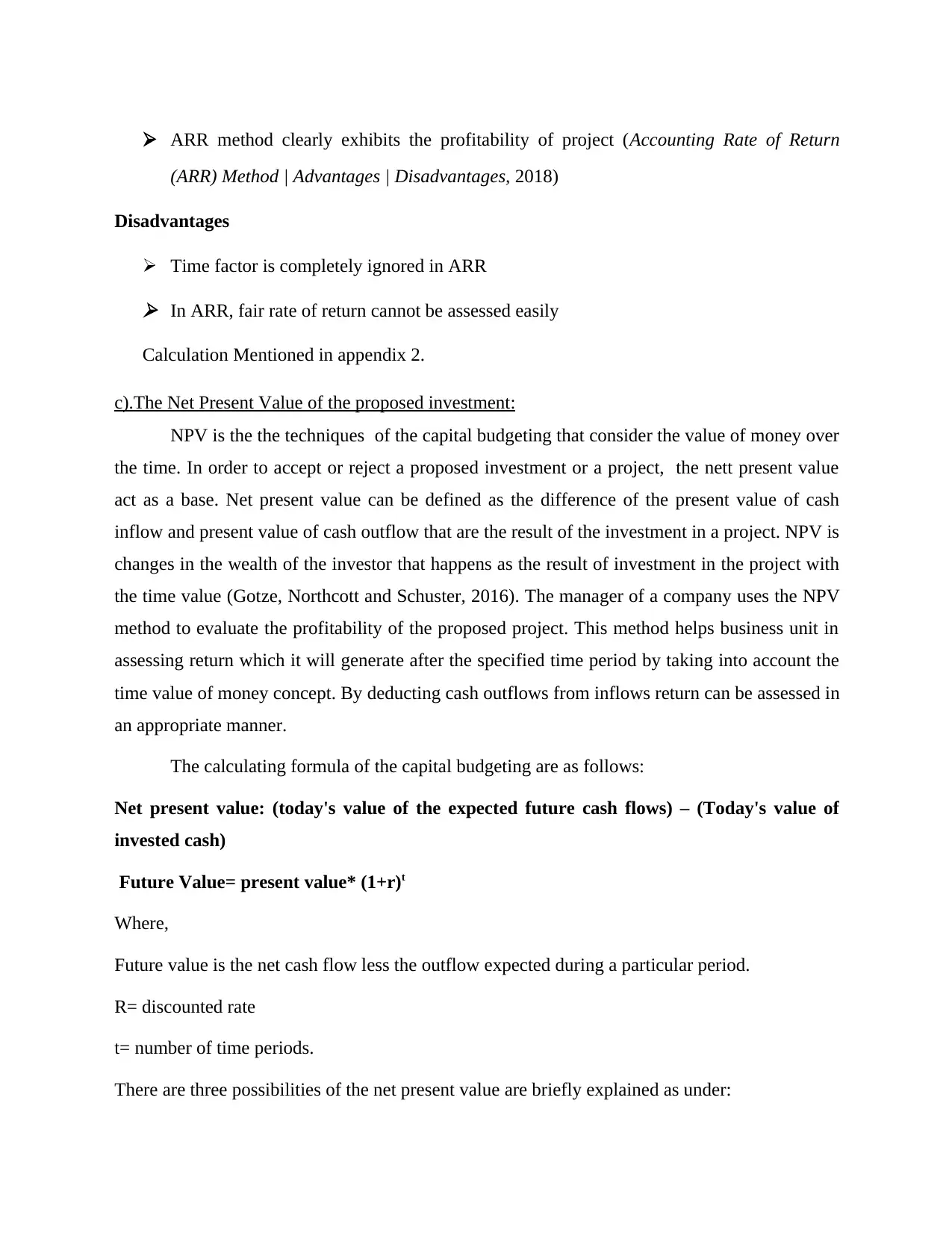
ARR method clearly exhibits the profitability of project (Accounting Rate of Return
(ARR) Method | Advantages | Disadvantages, 2018)
Disadvantages
Time factor is completely ignored in ARR In ARR, fair rate of return cannot be assessed easily
Calculation Mentioned in appendix 2.
c).The Net Present Value of the proposed investment:
NPV is the the techniques of the capital budgeting that consider the value of money over
the time. In order to accept or reject a proposed investment or a project, the nett present value
act as a base. Net present value can be defined as the difference of the present value of cash
inflow and present value of cash outflow that are the result of the investment in a project. NPV is
changes in the wealth of the investor that happens as the result of investment in the project with
the time value (Gotze, Northcott and Schuster, 2016). The manager of a company uses the NPV
method to evaluate the profitability of the proposed project. This method helps business unit in
assessing return which it will generate after the specified time period by taking into account the
time value of money concept. By deducting cash outflows from inflows return can be assessed in
an appropriate manner.
The calculating formula of the capital budgeting are as follows:
Net present value: (today's value of the expected future cash flows) – (Today's value of
invested cash)
Future Value= present value* (1+r)t
Where,
Future value is the net cash flow less the outflow expected during a particular period.
R= discounted rate
t= number of time periods.
There are three possibilities of the net present value are briefly explained as under:
(ARR) Method | Advantages | Disadvantages, 2018)
Disadvantages
Time factor is completely ignored in ARR In ARR, fair rate of return cannot be assessed easily
Calculation Mentioned in appendix 2.
c).The Net Present Value of the proposed investment:
NPV is the the techniques of the capital budgeting that consider the value of money over
the time. In order to accept or reject a proposed investment or a project, the nett present value
act as a base. Net present value can be defined as the difference of the present value of cash
inflow and present value of cash outflow that are the result of the investment in a project. NPV is
changes in the wealth of the investor that happens as the result of investment in the project with
the time value (Gotze, Northcott and Schuster, 2016). The manager of a company uses the NPV
method to evaluate the profitability of the proposed project. This method helps business unit in
assessing return which it will generate after the specified time period by taking into account the
time value of money concept. By deducting cash outflows from inflows return can be assessed in
an appropriate manner.
The calculating formula of the capital budgeting are as follows:
Net present value: (today's value of the expected future cash flows) – (Today's value of
invested cash)
Future Value= present value* (1+r)t
Where,
Future value is the net cash flow less the outflow expected during a particular period.
R= discounted rate
t= number of time periods.
There are three possibilities of the net present value are briefly explained as under:
⊘ This is a preview!⊘
Do you want full access?
Subscribe today to unlock all pages.

Trusted by 1+ million students worldwide
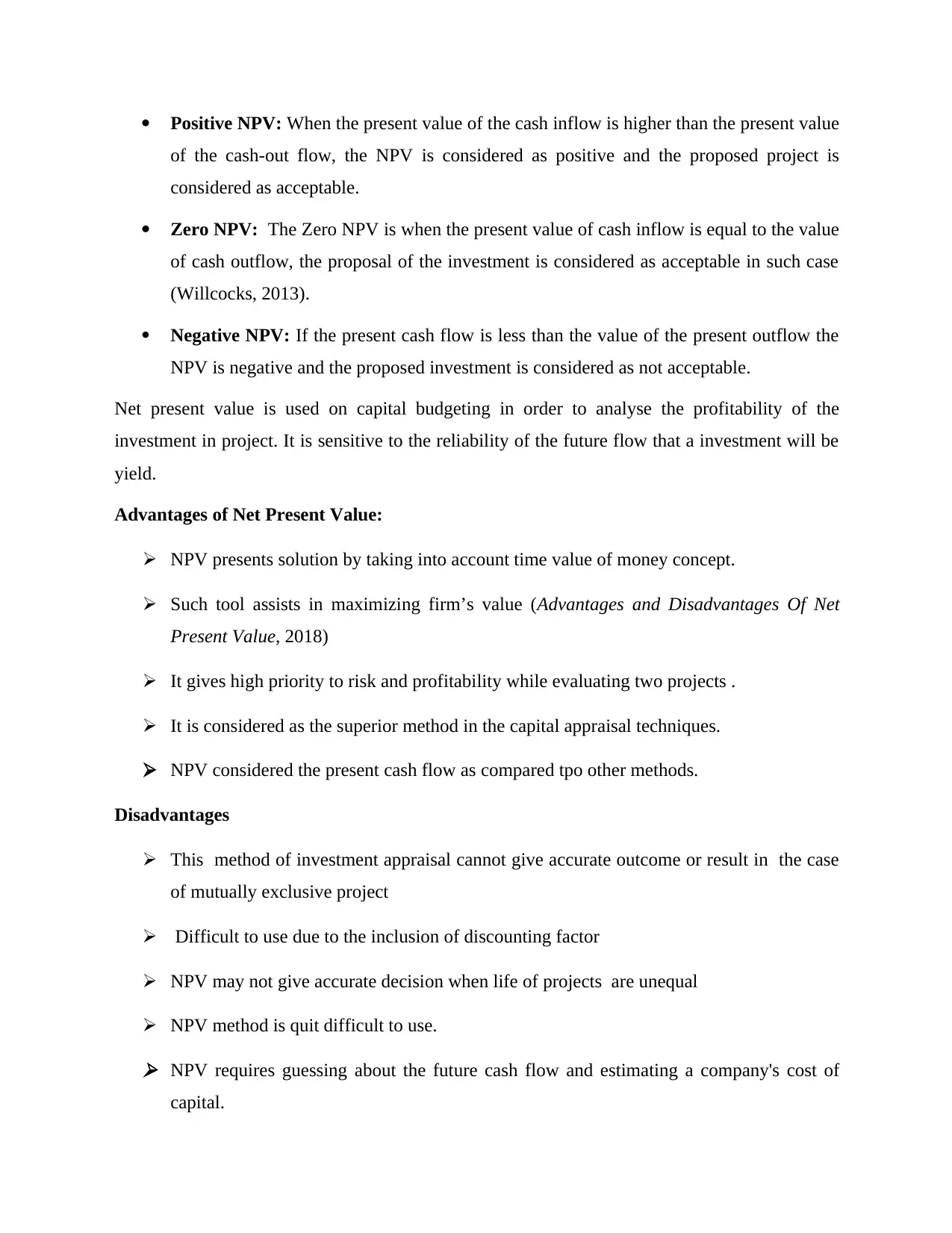
Positive NPV: When the present value of the cash inflow is higher than the present value
of the cash-out flow, the NPV is considered as positive and the proposed project is
considered as acceptable.
Zero NPV: The Zero NPV is when the present value of cash inflow is equal to the value
of cash outflow, the proposal of the investment is considered as acceptable in such case
(Willcocks, 2013).
Negative NPV: If the present cash flow is less than the value of the present outflow the
NPV is negative and the proposed investment is considered as not acceptable.
Net present value is used on capital budgeting in order to analyse the profitability of the
investment in project. It is sensitive to the reliability of the future flow that a investment will be
yield.
Advantages of Net Present Value:
NPV presents solution by taking into account time value of money concept.
Such tool assists in maximizing firm’s value (Advantages and Disadvantages Of Net
Present Value, 2018)
It gives high priority to risk and profitability while evaluating two projects .
It is considered as the superior method in the capital appraisal techniques.
NPV considered the present cash flow as compared tpo other methods.
Disadvantages
This method of investment appraisal cannot give accurate outcome or result in the case
of mutually exclusive project
Difficult to use due to the inclusion of discounting factor
NPV may not give accurate decision when life of projects are unequal
NPV method is quit difficult to use. NPV requires guessing about the future cash flow and estimating a company's cost of
capital.
of the cash-out flow, the NPV is considered as positive and the proposed project is
considered as acceptable.
Zero NPV: The Zero NPV is when the present value of cash inflow is equal to the value
of cash outflow, the proposal of the investment is considered as acceptable in such case
(Willcocks, 2013).
Negative NPV: If the present cash flow is less than the value of the present outflow the
NPV is negative and the proposed investment is considered as not acceptable.
Net present value is used on capital budgeting in order to analyse the profitability of the
investment in project. It is sensitive to the reliability of the future flow that a investment will be
yield.
Advantages of Net Present Value:
NPV presents solution by taking into account time value of money concept.
Such tool assists in maximizing firm’s value (Advantages and Disadvantages Of Net
Present Value, 2018)
It gives high priority to risk and profitability while evaluating two projects .
It is considered as the superior method in the capital appraisal techniques.
NPV considered the present cash flow as compared tpo other methods.
Disadvantages
This method of investment appraisal cannot give accurate outcome or result in the case
of mutually exclusive project
Difficult to use due to the inclusion of discounting factor
NPV may not give accurate decision when life of projects are unequal
NPV method is quit difficult to use. NPV requires guessing about the future cash flow and estimating a company's cost of
capital.
Paraphrase This Document
Need a fresh take? Get an instant paraphrase of this document with our AI Paraphraser
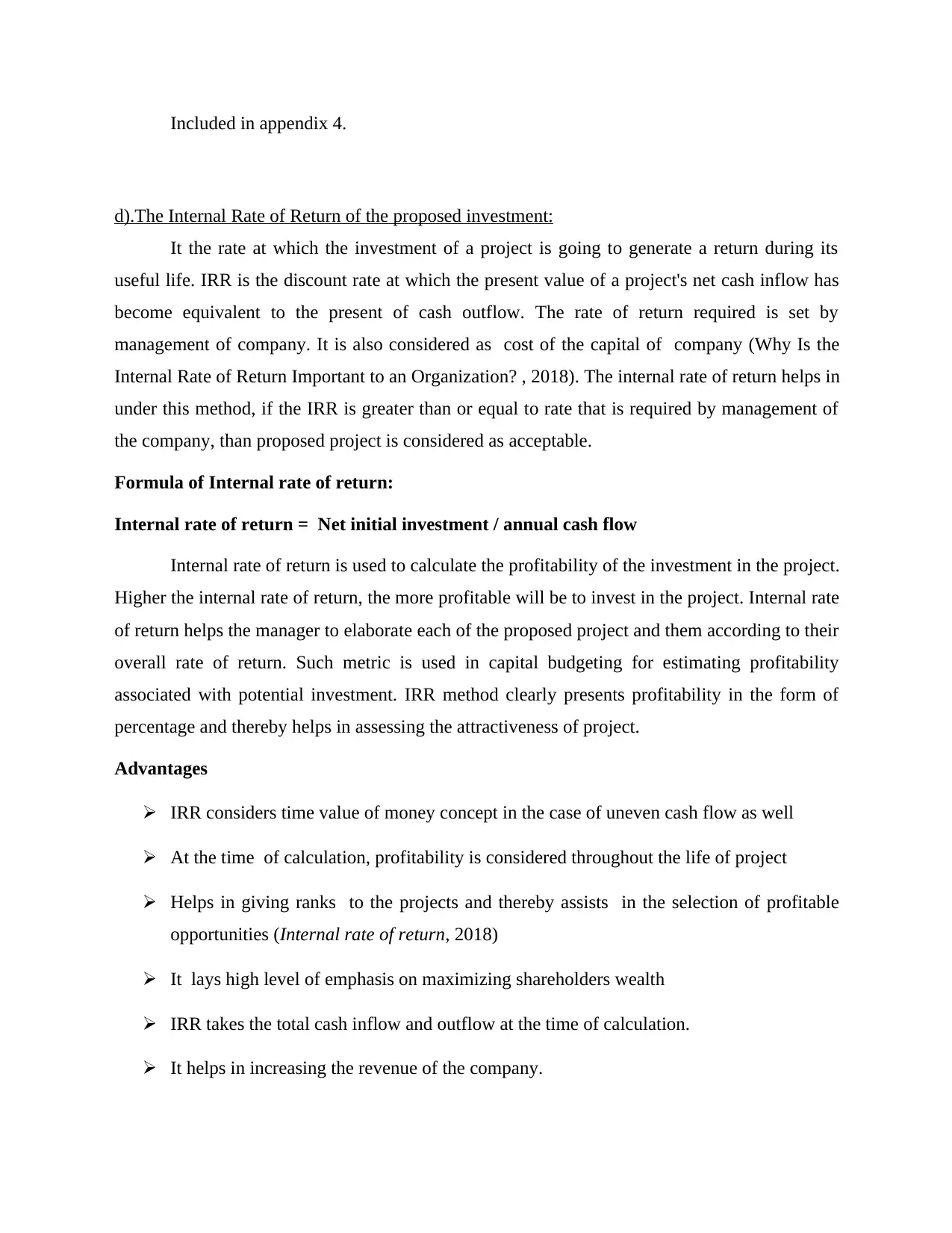
Included in appendix 4.
d).The Internal Rate of Return of the proposed investment:
It the rate at which the investment of a project is going to generate a return during its
useful life. IRR is the discount rate at which the present value of a project's net cash inflow has
become equivalent to the present of cash outflow. The rate of return required is set by
management of company. It is also considered as cost of the capital of company (Why Is the
Internal Rate of Return Important to an Organization? , 2018). The internal rate of return helps in
under this method, if the IRR is greater than or equal to rate that is required by management of
the company, than proposed project is considered as acceptable.
Formula of Internal rate of return:
Internal rate of return = Net initial investment / annual cash flow
Internal rate of return is used to calculate the profitability of the investment in the project.
Higher the internal rate of return, the more profitable will be to invest in the project. Internal rate
of return helps the manager to elaborate each of the proposed project and them according to their
overall rate of return. Such metric is used in capital budgeting for estimating profitability
associated with potential investment. IRR method clearly presents profitability in the form of
percentage and thereby helps in assessing the attractiveness of project.
Advantages
IRR considers time value of money concept in the case of uneven cash flow as well
At the time of calculation, profitability is considered throughout the life of project
Helps in giving ranks to the projects and thereby assists in the selection of profitable
opportunities (Internal rate of return, 2018)
It lays high level of emphasis on maximizing shareholders wealth
IRR takes the total cash inflow and outflow at the time of calculation.
It helps in increasing the revenue of the company.
d).The Internal Rate of Return of the proposed investment:
It the rate at which the investment of a project is going to generate a return during its
useful life. IRR is the discount rate at which the present value of a project's net cash inflow has
become equivalent to the present of cash outflow. The rate of return required is set by
management of company. It is also considered as cost of the capital of company (Why Is the
Internal Rate of Return Important to an Organization? , 2018). The internal rate of return helps in
under this method, if the IRR is greater than or equal to rate that is required by management of
the company, than proposed project is considered as acceptable.
Formula of Internal rate of return:
Internal rate of return = Net initial investment / annual cash flow
Internal rate of return is used to calculate the profitability of the investment in the project.
Higher the internal rate of return, the more profitable will be to invest in the project. Internal rate
of return helps the manager to elaborate each of the proposed project and them according to their
overall rate of return. Such metric is used in capital budgeting for estimating profitability
associated with potential investment. IRR method clearly presents profitability in the form of
percentage and thereby helps in assessing the attractiveness of project.
Advantages
IRR considers time value of money concept in the case of uneven cash flow as well
At the time of calculation, profitability is considered throughout the life of project
Helps in giving ranks to the projects and thereby assists in the selection of profitable
opportunities (Internal rate of return, 2018)
It lays high level of emphasis on maximizing shareholders wealth
IRR takes the total cash inflow and outflow at the time of calculation.
It helps in increasing the revenue of the company.
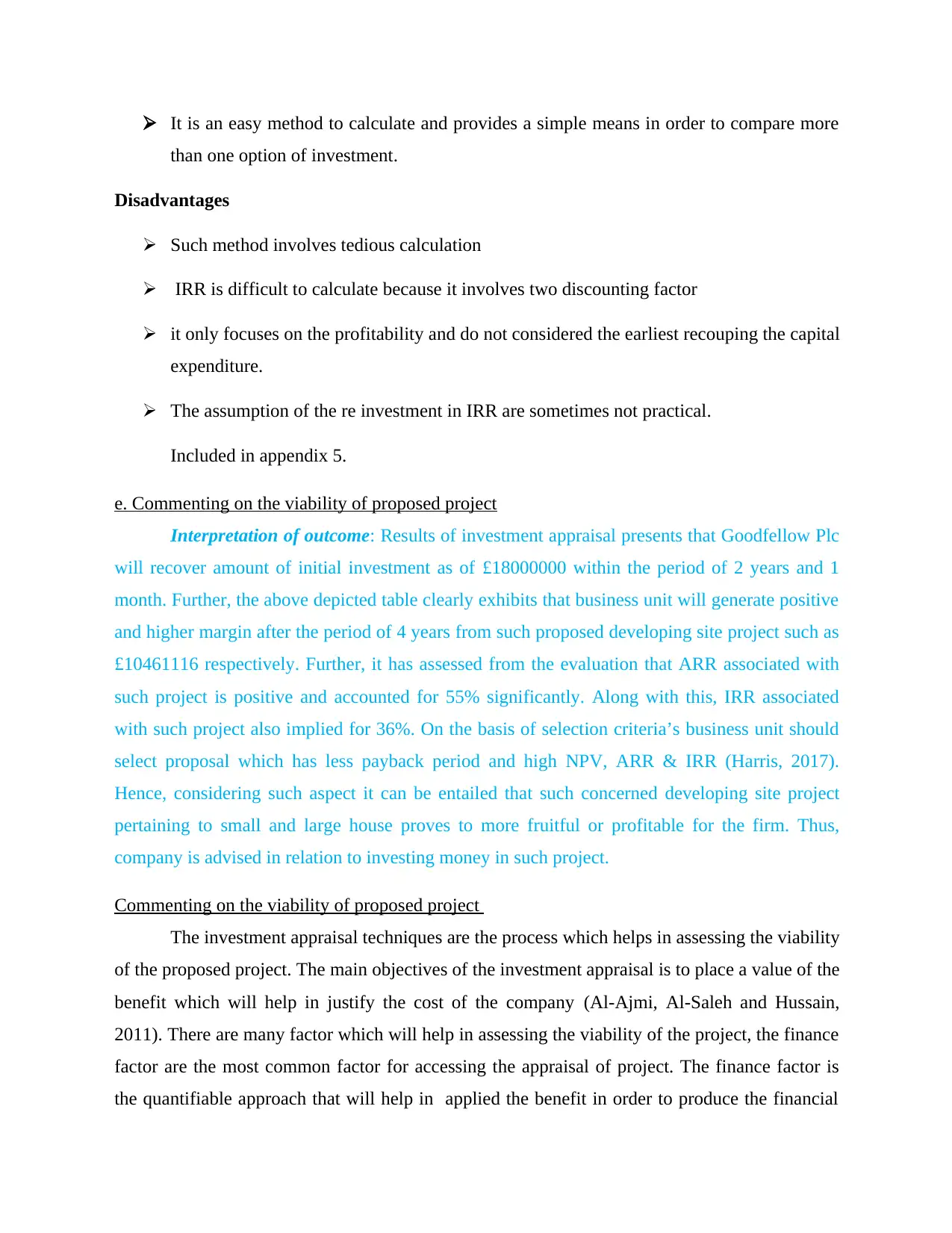
It is an easy method to calculate and provides a simple means in order to compare more
than one option of investment.
Disadvantages
Such method involves tedious calculation
IRR is difficult to calculate because it involves two discounting factor
it only focuses on the profitability and do not considered the earliest recouping the capital
expenditure.
The assumption of the re investment in IRR are sometimes not practical.
Included in appendix 5.
e. Commenting on the viability of proposed project
Interpretation of outcome: Results of investment appraisal presents that Goodfellow Plc
will recover amount of initial investment as of £18000000 within the period of 2 years and 1
month. Further, the above depicted table clearly exhibits that business unit will generate positive
and higher margin after the period of 4 years from such proposed developing site project such as
£10461116 respectively. Further, it has assessed from the evaluation that ARR associated with
such project is positive and accounted for 55% significantly. Along with this, IRR associated
with such project also implied for 36%. On the basis of selection criteria’s business unit should
select proposal which has less payback period and high NPV, ARR & IRR (Harris, 2017).
Hence, considering such aspect it can be entailed that such concerned developing site project
pertaining to small and large house proves to more fruitful or profitable for the firm. Thus,
company is advised in relation to investing money in such project.
Commenting on the viability of proposed project
The investment appraisal techniques are the process which helps in assessing the viability
of the proposed project. The main objectives of the investment appraisal is to place a value of the
benefit which will help in justify the cost of the company (Al-Ajmi, Al-Saleh and Hussain,
2011). There are many factor which will help in assessing the viability of the project, the finance
factor are the most common factor for accessing the appraisal of project. The finance factor is
the quantifiable approach that will help in applied the benefit in order to produce the financial
than one option of investment.
Disadvantages
Such method involves tedious calculation
IRR is difficult to calculate because it involves two discounting factor
it only focuses on the profitability and do not considered the earliest recouping the capital
expenditure.
The assumption of the re investment in IRR are sometimes not practical.
Included in appendix 5.
e. Commenting on the viability of proposed project
Interpretation of outcome: Results of investment appraisal presents that Goodfellow Plc
will recover amount of initial investment as of £18000000 within the period of 2 years and 1
month. Further, the above depicted table clearly exhibits that business unit will generate positive
and higher margin after the period of 4 years from such proposed developing site project such as
£10461116 respectively. Further, it has assessed from the evaluation that ARR associated with
such project is positive and accounted for 55% significantly. Along with this, IRR associated
with such project also implied for 36%. On the basis of selection criteria’s business unit should
select proposal which has less payback period and high NPV, ARR & IRR (Harris, 2017).
Hence, considering such aspect it can be entailed that such concerned developing site project
pertaining to small and large house proves to more fruitful or profitable for the firm. Thus,
company is advised in relation to investing money in such project.
Commenting on the viability of proposed project
The investment appraisal techniques are the process which helps in assessing the viability
of the proposed project. The main objectives of the investment appraisal is to place a value of the
benefit which will help in justify the cost of the company (Al-Ajmi, Al-Saleh and Hussain,
2011). There are many factor which will help in assessing the viability of the project, the finance
factor are the most common factor for accessing the appraisal of project. The finance factor is
the quantifiable approach that will help in applied the benefit in order to produce the financial
⊘ This is a preview!⊘
Do you want full access?
Subscribe today to unlock all pages.

Trusted by 1+ million students worldwide
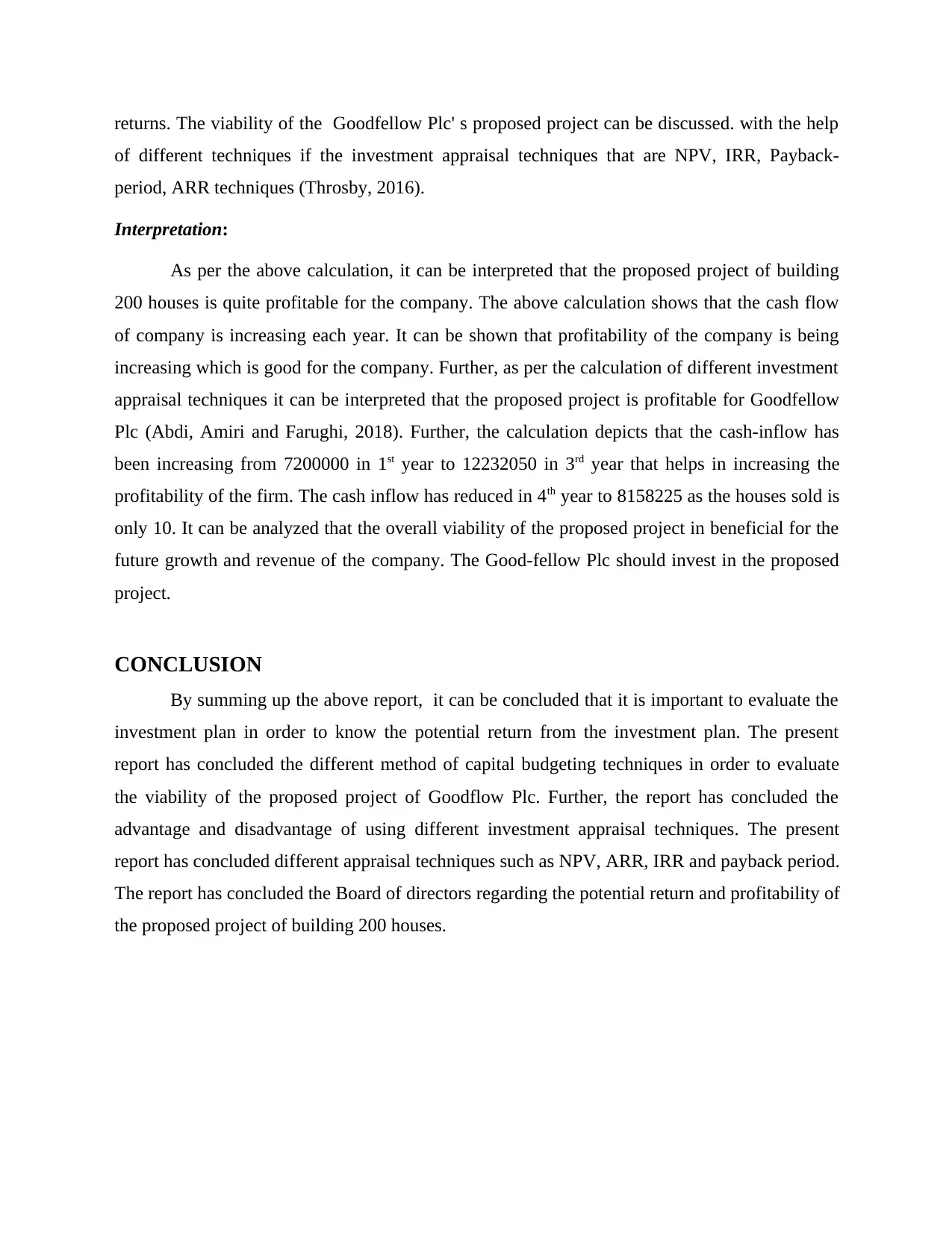
returns. The viability of the Goodfellow Plc' s proposed project can be discussed. with the help
of different techniques if the investment appraisal techniques that are NPV, IRR, Payback-
period, ARR techniques (Throsby, 2016).
Interpretation:
As per the above calculation, it can be interpreted that the proposed project of building
200 houses is quite profitable for the company. The above calculation shows that the cash flow
of company is increasing each year. It can be shown that profitability of the company is being
increasing which is good for the company. Further, as per the calculation of different investment
appraisal techniques it can be interpreted that the proposed project is profitable for Goodfellow
Plc (Abdi, Amiri and Farughi, 2018). Further, the calculation depicts that the cash-inflow has
been increasing from 7200000 in 1st year to 12232050 in 3rd year that helps in increasing the
profitability of the firm. The cash inflow has reduced in 4th year to 8158225 as the houses sold is
only 10. It can be analyzed that the overall viability of the proposed project in beneficial for the
future growth and revenue of the company. The Good-fellow Plc should invest in the proposed
project.
CONCLUSION
By summing up the above report, it can be concluded that it is important to evaluate the
investment plan in order to know the potential return from the investment plan. The present
report has concluded the different method of capital budgeting techniques in order to evaluate
the viability of the proposed project of Goodflow Plc. Further, the report has concluded the
advantage and disadvantage of using different investment appraisal techniques. The present
report has concluded different appraisal techniques such as NPV, ARR, IRR and payback period.
The report has concluded the Board of directors regarding the potential return and profitability of
the proposed project of building 200 houses.
of different techniques if the investment appraisal techniques that are NPV, IRR, Payback-
period, ARR techniques (Throsby, 2016).
Interpretation:
As per the above calculation, it can be interpreted that the proposed project of building
200 houses is quite profitable for the company. The above calculation shows that the cash flow
of company is increasing each year. It can be shown that profitability of the company is being
increasing which is good for the company. Further, as per the calculation of different investment
appraisal techniques it can be interpreted that the proposed project is profitable for Goodfellow
Plc (Abdi, Amiri and Farughi, 2018). Further, the calculation depicts that the cash-inflow has
been increasing from 7200000 in 1st year to 12232050 in 3rd year that helps in increasing the
profitability of the firm. The cash inflow has reduced in 4th year to 8158225 as the houses sold is
only 10. It can be analyzed that the overall viability of the proposed project in beneficial for the
future growth and revenue of the company. The Good-fellow Plc should invest in the proposed
project.
CONCLUSION
By summing up the above report, it can be concluded that it is important to evaluate the
investment plan in order to know the potential return from the investment plan. The present
report has concluded the different method of capital budgeting techniques in order to evaluate
the viability of the proposed project of Goodflow Plc. Further, the report has concluded the
advantage and disadvantage of using different investment appraisal techniques. The present
report has concluded different appraisal techniques such as NPV, ARR, IRR and payback period.
The report has concluded the Board of directors regarding the potential return and profitability of
the proposed project of building 200 houses.
Paraphrase This Document
Need a fresh take? Get an instant paraphrase of this document with our AI Paraphraser
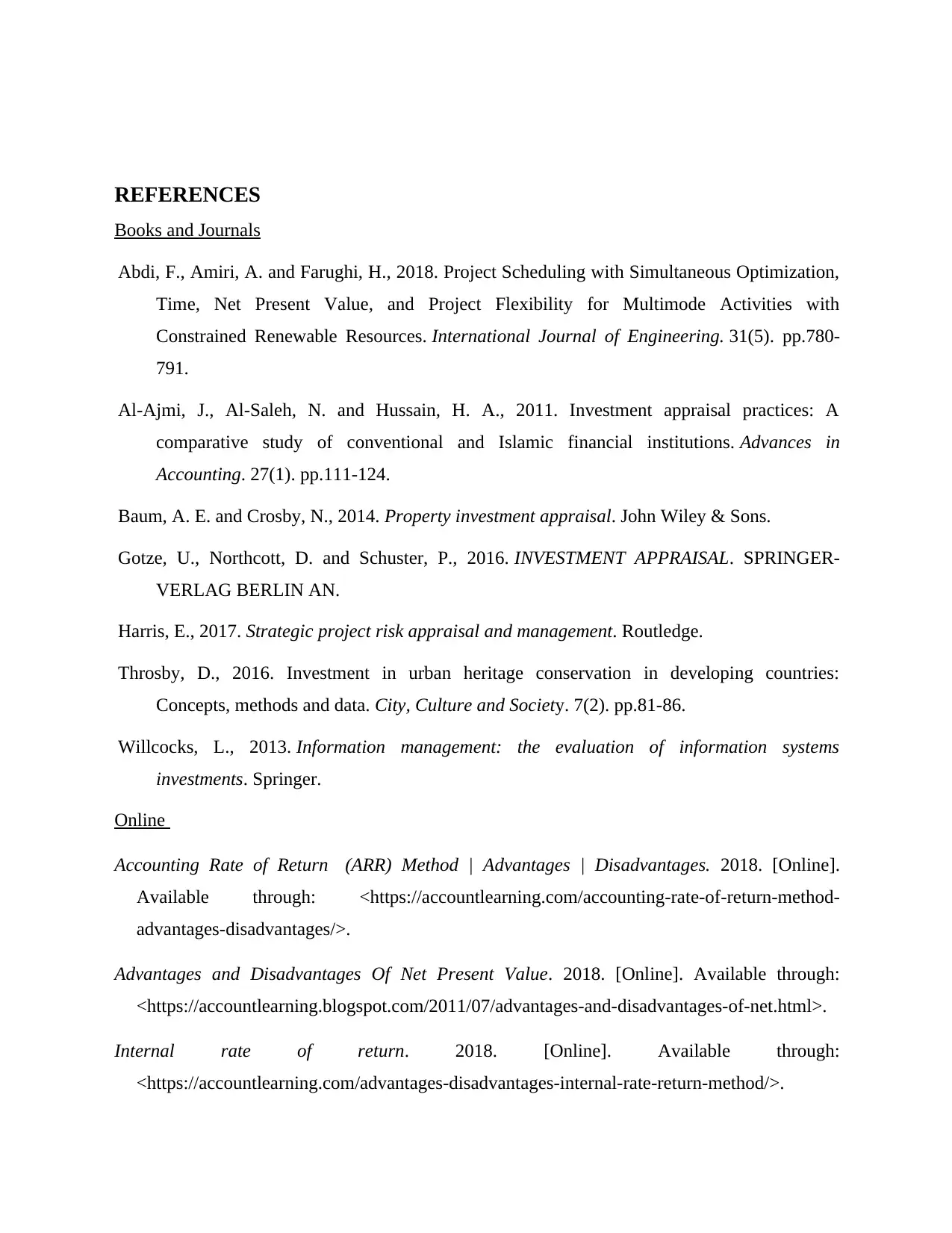
REFERENCES
Books and Journals
Abdi, F., Amiri, A. and Farughi, H., 2018. Project Scheduling with Simultaneous Optimization,
Time, Net Present Value, and Project Flexibility for Multimode Activities with
Constrained Renewable Resources. International Journal of Engineering. 31(5). pp.780-
791.
Al-Ajmi, J., Al-Saleh, N. and Hussain, H. A., 2011. Investment appraisal practices: A
comparative study of conventional and Islamic financial institutions. Advances in
Accounting. 27(1). pp.111-124.
Baum, A. E. and Crosby, N., 2014. Property investment appraisal. John Wiley & Sons.
Gotze, U., Northcott, D. and Schuster, P., 2016. INVESTMENT APPRAISAL. SPRINGER-
VERLAG BERLIN AN.
Harris, E., 2017. Strategic project risk appraisal and management. Routledge.
Throsby, D., 2016. Investment in urban heritage conservation in developing countries:
Concepts, methods and data. City, Culture and Society. 7(2). pp.81-86.
Willcocks, L., 2013. Information management: the evaluation of information systems
investments. Springer.
Online
Accounting Rate of Return (ARR) Method | Advantages | Disadvantages. 2018. [Online].
Available through: <https://accountlearning.com/accounting-rate-of-return-method-
advantages-disadvantages/>.
Advantages and Disadvantages Of Net Present Value. 2018. [Online]. Available through:
<https://accountlearning.blogspot.com/2011/07/advantages-and-disadvantages-of-net.html>.
Internal rate of return. 2018. [Online]. Available through:
<https://accountlearning.com/advantages-disadvantages-internal-rate-return-method/>.
Books and Journals
Abdi, F., Amiri, A. and Farughi, H., 2018. Project Scheduling with Simultaneous Optimization,
Time, Net Present Value, and Project Flexibility for Multimode Activities with
Constrained Renewable Resources. International Journal of Engineering. 31(5). pp.780-
791.
Al-Ajmi, J., Al-Saleh, N. and Hussain, H. A., 2011. Investment appraisal practices: A
comparative study of conventional and Islamic financial institutions. Advances in
Accounting. 27(1). pp.111-124.
Baum, A. E. and Crosby, N., 2014. Property investment appraisal. John Wiley & Sons.
Gotze, U., Northcott, D. and Schuster, P., 2016. INVESTMENT APPRAISAL. SPRINGER-
VERLAG BERLIN AN.
Harris, E., 2017. Strategic project risk appraisal and management. Routledge.
Throsby, D., 2016. Investment in urban heritage conservation in developing countries:
Concepts, methods and data. City, Culture and Society. 7(2). pp.81-86.
Willcocks, L., 2013. Information management: the evaluation of information systems
investments. Springer.
Online
Accounting Rate of Return (ARR) Method | Advantages | Disadvantages. 2018. [Online].
Available through: <https://accountlearning.com/accounting-rate-of-return-method-
advantages-disadvantages/>.
Advantages and Disadvantages Of Net Present Value. 2018. [Online]. Available through:
<https://accountlearning.blogspot.com/2011/07/advantages-and-disadvantages-of-net.html>.
Internal rate of return. 2018. [Online]. Available through:
<https://accountlearning.com/advantages-disadvantages-internal-rate-return-method/>.
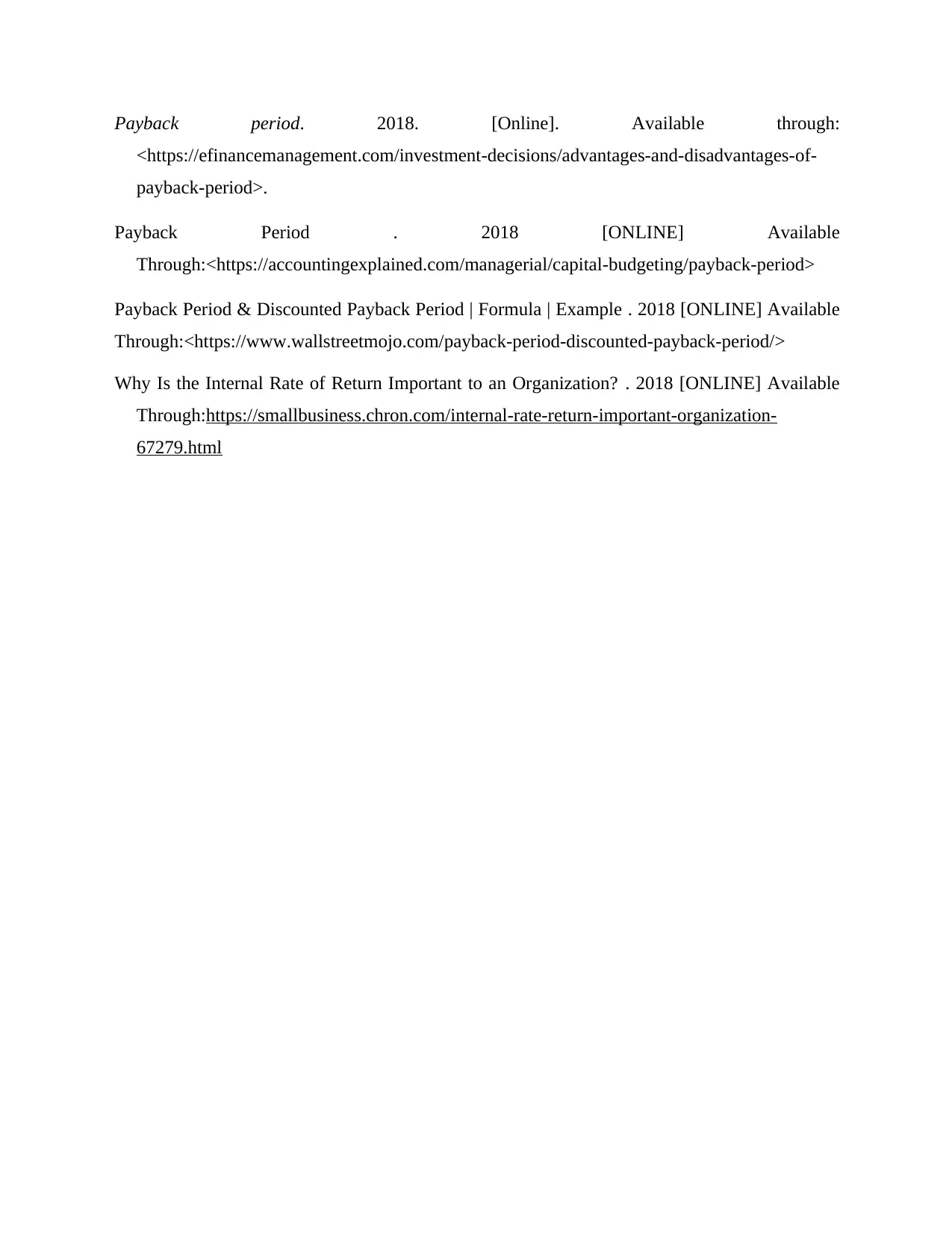
Payback period. 2018. [Online]. Available through:
<https://efinancemanagement.com/investment-decisions/advantages-and-disadvantages-of-
payback-period>.
Payback Period . 2018 [ONLINE] Available
Through:<https://accountingexplained.com/managerial/capital-budgeting/payback-period>
Payback Period & Discounted Payback Period | Formula | Example . 2018 [ONLINE] Available
Through:<https://www.wallstreetmojo.com/payback-period-discounted-payback-period/>
Why Is the Internal Rate of Return Important to an Organization? . 2018 [ONLINE] Available
Through:https://smallbusiness.chron.com/internal-rate-return-important-organization-
67279.html
<https://efinancemanagement.com/investment-decisions/advantages-and-disadvantages-of-
payback-period>.
Payback Period . 2018 [ONLINE] Available
Through:<https://accountingexplained.com/managerial/capital-budgeting/payback-period>
Payback Period & Discounted Payback Period | Formula | Example . 2018 [ONLINE] Available
Through:<https://www.wallstreetmojo.com/payback-period-discounted-payback-period/>
Why Is the Internal Rate of Return Important to an Organization? . 2018 [ONLINE] Available
Through:https://smallbusiness.chron.com/internal-rate-return-important-organization-
67279.html
⊘ This is a preview!⊘
Do you want full access?
Subscribe today to unlock all pages.

Trusted by 1+ million students worldwide
1 out of 15
Related Documents
Your All-in-One AI-Powered Toolkit for Academic Success.
+13062052269
info@desklib.com
Available 24*7 on WhatsApp / Email
![[object Object]](/_next/static/media/star-bottom.7253800d.svg)
Unlock your academic potential
Copyright © 2020–2025 A2Z Services. All Rights Reserved. Developed and managed by ZUCOL.




